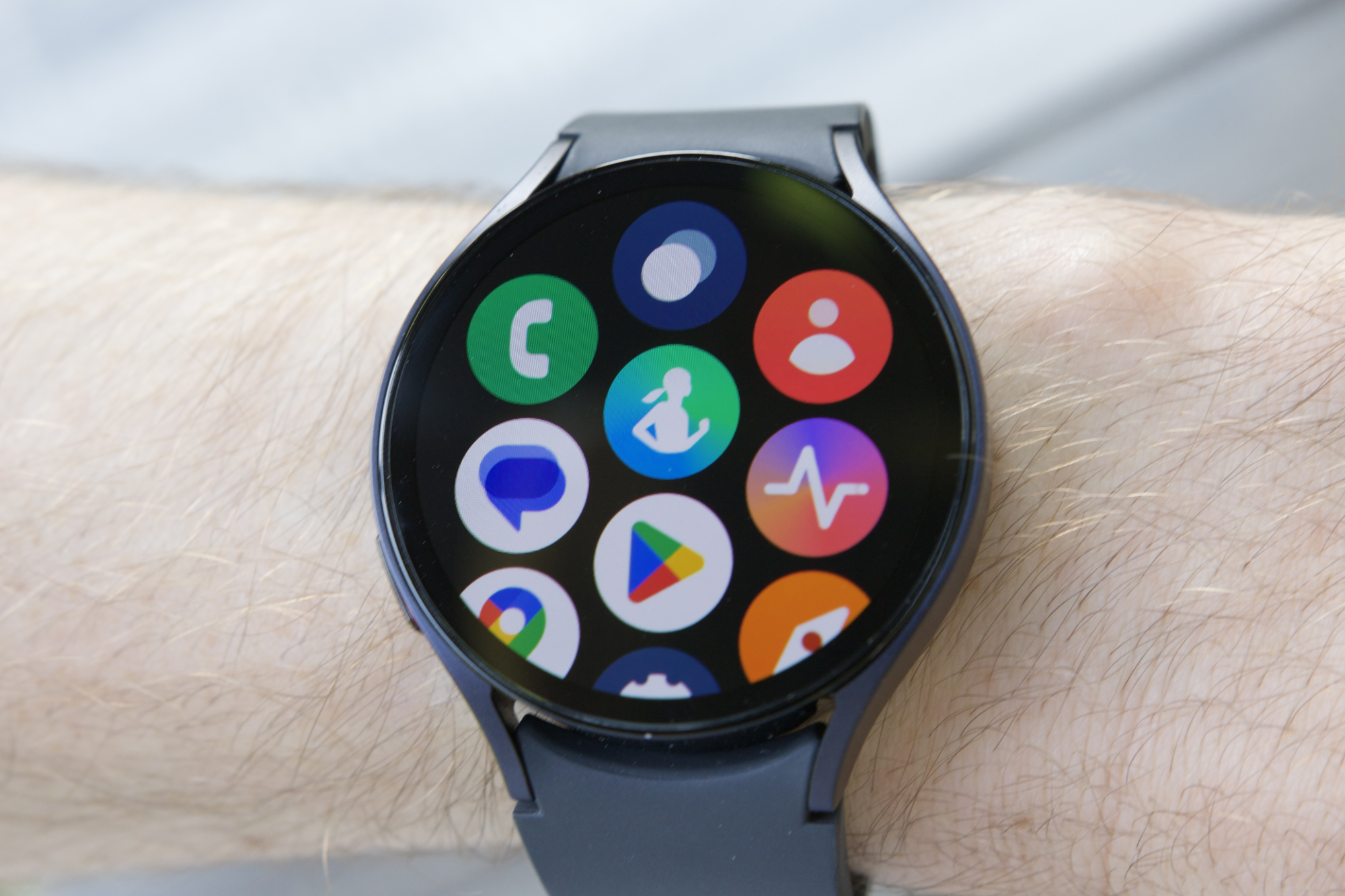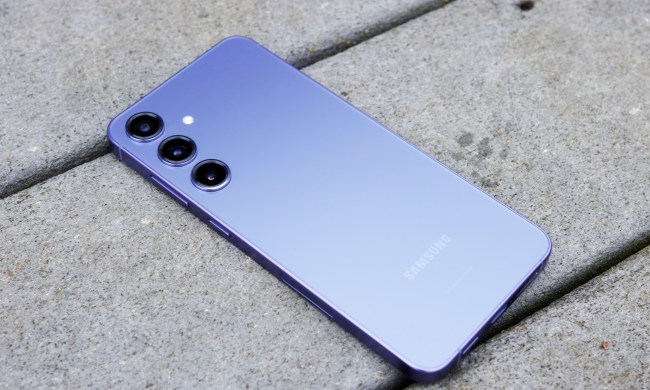“The Samsung Galaxy Watch 6 is the new go-to recommendation if you want an Android smartwatch. It's reliable, powerful, and still a great value.”
- Very comfortable design
- Colorful and bright display
- Smaller bezels are lovely
- Samsung Health keeps getting better
- Good, reliable performance
- Much-improved battery life
- Still a great value
- Wear OS still has its issues
- Slightly more expensive
Small year-over-year upgrades aren’t anything new in the mobile tech space, and the Samsung Galaxy Watch 6 is the latest device to join the iterative update train. Compared side by side with its predecessor, it looks virtually identical — and the feature set is eerily similar, too.
Considering that, I wouldn’t blame you for thinking the Galaxy Watch 6 is a boring upgrade, one that’s not worth your time or attention. But to do so would be to ignore what is an excellent smartwatch through and through. The Samsung Galaxy Watch 6 may not be the most jaw-dropping release of the year, but if you’re in the market for an Android smartwatch that has a comfortable design, reliable battery life, and a powerful health-tracking suite, you’ll be hard-pressed to do better than this.
About our Samsung Galaxy Watch 6 review
This review of the Samsung Galaxy Watch 6 was written by me (Joe Maring) after wearing the 44mm model of the Galaxy Watch 6 for over a week in the U.S. It was originally published on August 9, 2023. The Galaxy Watch 6 was connected to a Samsung Galaxy Z Flip 5 throughout the entire review period.
The review was updated on August 14 to mention that the Galaxy Watch 6 is now available for immediate purchase.
Samsung Galaxy Watch 6: design and hardware
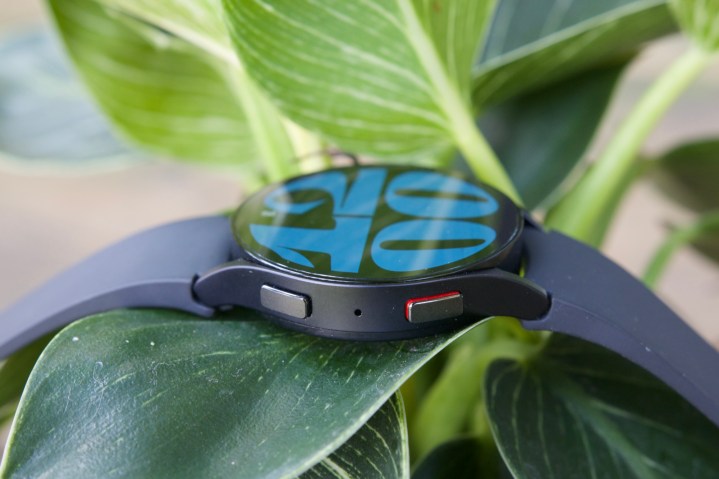
The Samsung Galaxy Watch 6 keeps the same general shape and design of last year’s Galaxy Watch 5 — which also looked virtually identical to the Galaxy Watch 4 from 2021. The Galaxy Watch 6 comes in your choice of two case sizes, either 40mm or 44mm. I’ve been wearing the 44mm model during my review in the graphite (aka black) color, which is available for both sizes. You can also get a silver finish in the same 44mm style, while the 40mm Watch 6 gets a new gold color.
As much as I’d like to see Samsung flex its design chops more with future generations, it’s difficult to find any real complaints about the design the company appears to have settled on. It’s simple, comfortable, and just about perfect for what it is.

The Galaxy Watch 6 has been a pleasure to wear on my wrist since the moment I strapped it on. Not once have I found it too heavy or bulky, as even in the larger 44mm size, I think it looks great on my small wrist. I also find the included silicon band to be very comfortable, and it’s now easier to swap with a different one, thanks to Samsung’s new “one-click” design.
Just press and hold a button near the base of the band, pull it off, and that’s it. The one-click system is present on all of Samsung’s new watch bands, and if nothing there catches your fancy, you can still use any standard 20mm band you’d like — making it dead simple to find a Galaxy Watch 6 band you’ll love.
Samsung Galaxy Watch 6: display
The Galaxy Watch 6 uses a Super AMOLED panel for its display, though the size and resolution change depending on which size you choose. The 40mm model has a 1.3-inch 432 x 432 screen, while the 44mm one has a 1.5-inch 480 x 480 screen.
That’s an increase of 0.1 inches for both models compared to the Galaxy Watch 5, and Samsung achieved this by significantly shrinking the bezels around the display. That doesn’t sound like a huge change on paper, but when dealing with a display this tiny, it makes a pretty noticeable difference in day-to-day use.
You see basically the same amount of content on the screen at any given time, but apps, watch faces, and other elements get to stretch out to fill almost the entire front of the Galaxy Watch 6. It looks very futuristic — especially compared to the Google Pixel Watch and its gargantuan bezels.
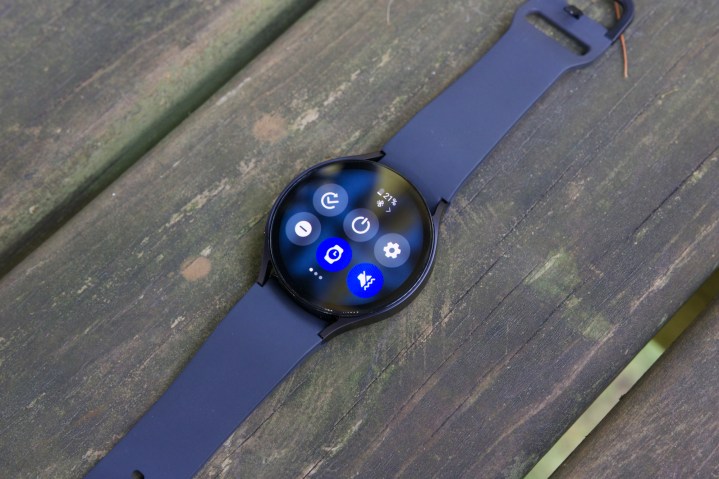
There’s another big upgrade this year, and that’s the jump from 1,000 nits of brightness on the Watch 5 to 2,000 nits on the Galaxy Watch 6. It’s been very sunny in Southwest Michigan while I’ve been wearing the Watch 6, and not once have I found the display difficult to see — even with the harsh July sunshine bearing down on it. From checking notifications outside to quickly glancing at workout stats, it’s been an incredible upgrade to have.
Lastly, just like the Watch 5 and Watch 4 before it, you can still swipe around the edge of the Galaxy Watch 6’s display to scroll through notifications, apps, etc. While not as magical as the rotating crown on the Samsung Galaxy Watch 6 Classic, it’s worked well on the Watch 6 — noticeably better than the janky performance I had on the Galaxy Watch 5 last year.
Samsung Galaxy Watch 6: health tracking

Samsung didn’t make any drastic health-tracking upgrades to the Galaxy Watch 6, but considering how robust the existing tools are, that’s hardly a bad thing. Similar to the Apple Watch, your main activity tracking is scored by closing three rings each day — including your steps, active time, and active calories. It’s not the most original idea, but it’s clean, simple, and very easy to follow.
Samsung’s Bioelectrical Impedance Analysis (BIA) sensor returns this year, allowing you to do a full body composition scan that reveals your skeletal muscle, fat mass, body water, body fat, body mass index (BMI), and basal metabolic rate (BMR) within seconds. It’s amazing being able to get so much extra data about your body at any given time, though I still wish Samsung did a better job of telling you what these numbers mean. The Samsung Health app neatly presents this data and shows how it changes over time, but it doesn’t provide any context or explanation beyond that.
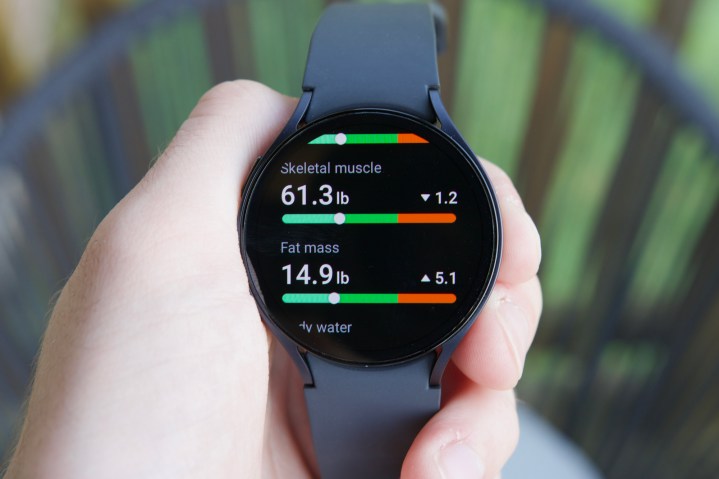
Also returning is the temperature sensor that was introduced on the Galaxy Watch 5. Unlike last year, though, you don’t have to wait months to do anything with it! Right out of the box, the Galaxy Watch 6 uses the sensor to automatically measure your skin temperature while you sleep. Again, the data could be explained better, but it’s great having it working from day one.
The rest of the health suite is expected, but it has everything you could ask for:
- 24/7 heart-rate monitoring
- 90-plus exercise modes
- Automatic workout detection
- Stress monitoring
- Cycle tracking
- SpO2 (blood oxygen) tracking
- ECG app
In addition to all of that, there are a couple of new health features debuting on the Galaxy Watch 6: Advanced Sleep Coaching and Personalized Heart Rate Zones. The sleep-tracking experience is largely the same as it’s been for a couple of years, though Samsung now displays your sleep data much more clearly on the Galaxy Watch 6. You can also now access Sleep Coaching features directly on the watch instead of needing to open the Samsung Health app on your phone.
The Personalized Heart Rate Zone feature creates custom heart rate zones for you to follow during your running workouts. It’s something that other smartwatches and fitness trackers have had for some time now, but it’s still nice to see Samsung get on the bandwagon — even if it’s a bit late to the party.
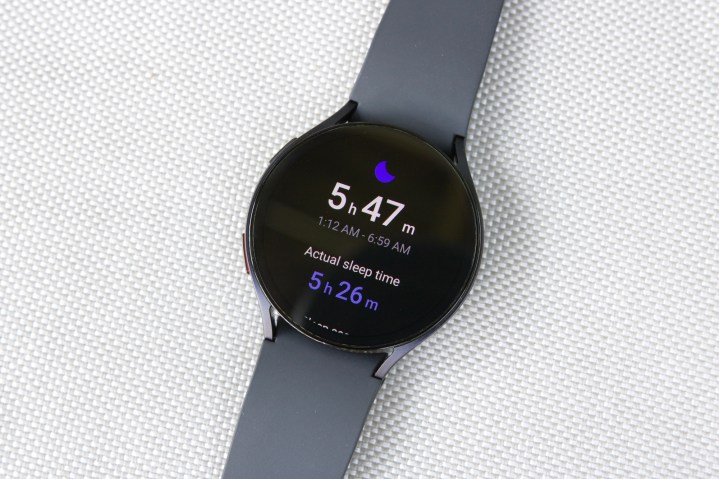
Samsung throws a lot of health features at you with the Galaxy Watch 6, and while some things could benefit from better explanations, it’s impressive how well all of it works together. Wearing the Galaxy Watch 6 alongside a Garmin Fenix 7 Pro and Apple Watch Ultra, the Galaxy Watch 6 isn’t wildly inaccurate in any of its stats compared to those other watches. The Samsung Health app can be a little daunting at first, but it’s highly customizable and has a load of data to sift through. I also appreciate that it packs all of your information into one place, unlike Apple, which still separates your health data between two apps (Apple Fitness and Apple Health).
The best part? Compared to the Oura Ring and the Fitbit platform on the Pixel Watch — both of which have recurring monthly subscriptions — Samsung Health is 100% free to use. That’s an increasingly rare thing in the health-tracking space, and it’s great that Samsung continues to offer so many tools without locking them behind a paywall.
Samsung Galaxy Watch 6: performance and software
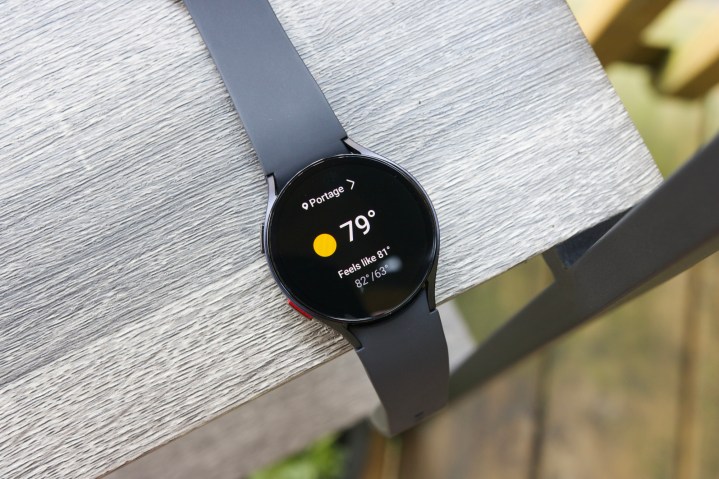
Powering the Galaxy Watch 6 is Samsung’s in-house Exynos W930 dual-core processor with a clock speed of 1.4GHz. It’s a subtle upgrade over the W920 chip in the Watch 5, with Samsung’s most impressive claim being that the Galaxy Watch 6 can open applications 18% faster than before.
While I would have loved to see Samsung finally adopt Qualcomm’s Snapdragon W5 Gen 1 platform, performance on the Galaxy Watch 6 has been (mostly) reliable. Apps do open quickly, scrolling through notifications is a smooth experience, and I never feel like I’m waiting on the Watch 6 to keep up with me. It’s not as buttery smooth as the Apple Watch Series 8 (the gold standard for smartwatch performance), but it definitely gets the job done.
On the software front, the Galaxy Watch 6 is running Wear OS 4.0 with Samsung’s One UI 5.0 Watch interface layered on top. This is the first smartwatch to ship with Wear OS 4.0 and — big surprise — it’s a lot like Wear OS 3.0.

The core user interface of the Galaxy Watch 6 is unchanged from previous versions. Swipe down from your clock face to access your Quick Settings, swipe up to view your apps, swipe right to see your notifications, and swipe left to cycle through your tiles.
Notifications have been reliable on the Galaxy Watch 6, and the vibration motor feels good and is difficult to miss (even if it doesn’t feel as nice as Apple’s Taptic Engine). You also have a lot of control over notifications, with options to reply to messages/emails with premade quick replies, emojis, or a full QWERTY keyboard (with very good autocorrect) to type whatever you want.
Unsurprisingly, apps are still fairly limited on Wear OS. The addition of WhatsApp last month was great to see, but there are still plenty of big names missing — including Telegram, Starbucks, Delta, and others. The Apple Watch has had a significant advantage in this department for years, and that doesn’t appear to be changing any time soon.
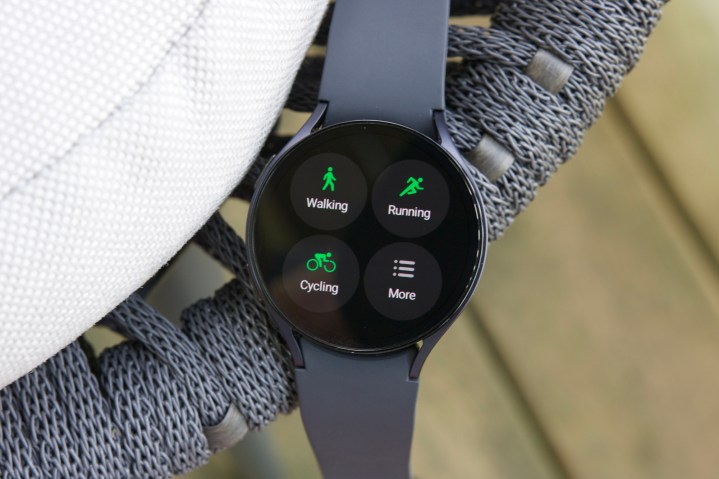
Throughout my time with the Galaxy Watch 6, there have been two instances where things got funky. During my initial setup of the watch, it was running very slowly — even when doing something as simple as scrolling through my widgets/tiles. This went away after an hour or so once the setup process was fully complete, but it still wasn’t the best note to start on.
I also had one afternoon when the touchscreen refused to acknowledge my input. The buttons still worked, but tapping the screen did absolutely nothing. The Galaxy Watch 6 corrected itself after a minute or so, but there was no rhyme or reason for it acting up like this.
It’s also worth mentioning that Digital Trends’ Andy Boxall experienced similar performance gaffes with the Galaxy Watch 6 Classic — including one instance where the watch refused to exit sleep mode and required a full restart to do so. These could just be one-off issues with our specific review units, but Wear OS hasn’t exactly been known for flawless operation over the years. The Galaxy Watch 6 may have the latest version of Google’s smartwatch platform, but it appears to be just as randomly buggy as it’s always been.
Samsung Galaxy Watch 6: battery life
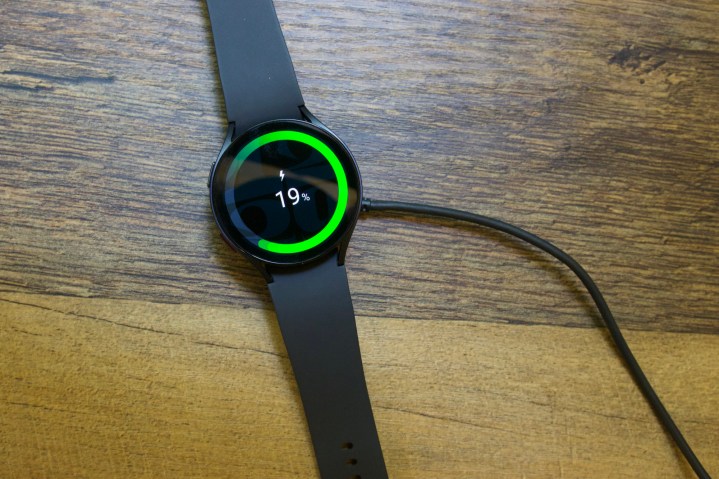
Battery life on last year’s Galaxy Watch 5 was disappointing, to say the least. Samsung promised 40 to 50 hours of use per charge, but in my testing, I was having to look for a charger after less than 24 hours. Despite a very subtle upgrade in battery capacity, the Galaxy Watch 6 has proven to be significantly better.
If I put the Galaxy Watch 6 on my wrist around 7 a.m. or 8 a.m., I’m easily getting to 10 p.m. or 11 p.m. that night with 60% to 70% battery still remaining. That’s with the always-on display enabled, a steady stream of notifications from my Z Flip 5, recording outdoor walks, and random tasks like checking the weather or changing my clock face.
The Galaxy Watch 6 has very good battery life.
Seven hours of sleep tracking uses about 10% of the battery, which usually lets me get late into the evening of the following day before I have to put the Galaxy Watch 6 on its charger. I was able to squeeze by with two days of use and two nights of sleep tracking on a single charge, but more likely than not, you’ll need to top-up before bed on day two if you want enough battery to track your sleep that night.
This is very good battery life, and much better than what I experienced on the Galaxy Watch 5. If you turn off features like the always-on display or automatic hear -rate tracking, you could very likely extend its endurance even more. I like that there are options to further extend the Watch 6’s battery, but I’m also glad Samsung doesn’t make you gut the experience just to get reliable battery life.
As for the charging experience, it’s the same 10-watt charging that was introduced last year. You’ll get a 30% charge after just 15 minutes and up to 45% after 30 minutes, but getting all the way up to 100% takes a little over an hour. Annoyingly, Samsung still uses the WPC standard for charging the Galaxy Watch 6, which means you have to use the proprietary sharing cable that comes in the box. Standard Qi wireless charging does not work with the Galaxy Watch 6 — even if you place it on the back of a Samsung phone like the Galaxy S23 Ultra.
Samsung Galaxy Watch 6: price and availability
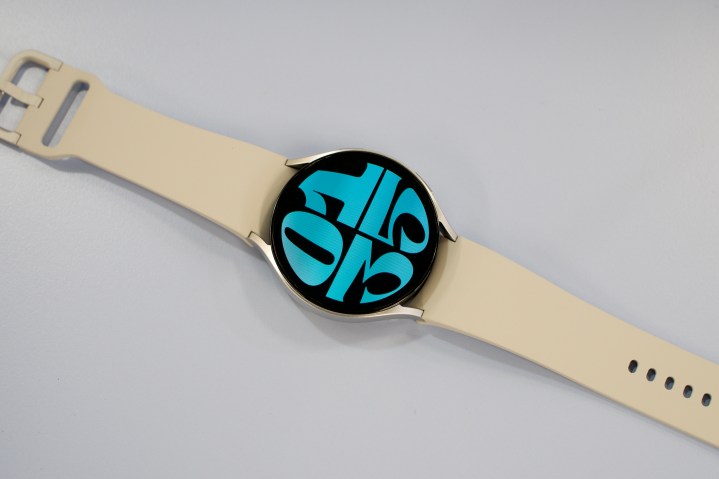
The Samsung Galaxy Watch 6 starts at $300 for the smaller 40mm size, or you can get the larger 44mm option (the one I reviewed) for $330. Keep in mind that those are prices for the Bluetooth/Wi-Fi variants. If you want 4G LTE connectivity, prices increase to $350 and $380, respectively. Just like the Galaxy Watch 5, the Galaxy Watch 6 is only compatible with Android phones. If you have an iPhone, you’ll need to look elsewhere.
The Samsung Galaxy Watch 6 is available for immediate purchase from Samsung.com and most major retailers — including Amazon, Best Buy, and others.
Samsung Galaxy Watch 6: verdict
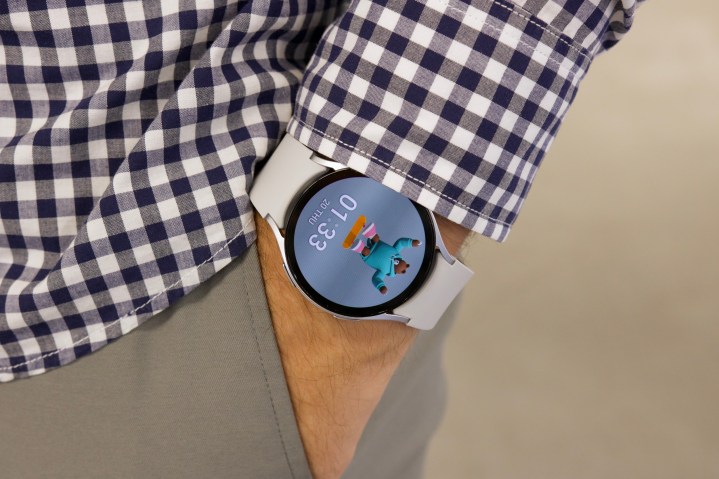
I won’t beat around the bush: If you’re in the market for a smartwatch that works with your Android phone, the Samsung Galaxy Watch 6 is the watch to buy. It’s that simple.
The Galaxy Watch 5 was already a fantastic wearable, and while the on-paper changes between it and the Galaxy Watch 6 appear quite small, the Watch 6 fixes almost all of the complaints I had about its predecessor. The display is bigger and brighter, the temperature sensor actually does something, and battery life is much more reliable. These changes all translate to meaningful improvements in day-to-day use, and everything that was excellent on the Watch 5 is just as lovely on the Watch 6.
Am I thrilled with the $20 price increase this year? No. But considering the changes Samsung made with this generation, it’s a well-justified increase. The Galaxy Watch 6 is also still $50 cheaper than the Google Pixel Watch and is a far better product in almost every way imaginable. And as good as the Galaxy Watch 6 Classic is — unless you need the rotating bezel or fancier design — I’d argue you’re better off saving $100 and just sticking with the regular Watch 6.
If you’re in the market for a smartwatch that works with your Android phone, the Samsung Galaxy Watch 6 is the watch to buy.
Wear OS as a platform has lingering issues I’d like to see Google address, but when it comes to buying an Android smartwatch right now in 2023, there’s no other option I’d recommend more strongly than the Samsung Galaxy Watch 6. It’s not an exciting product, but it’s a damn good one, and you should absolutely buy it.


